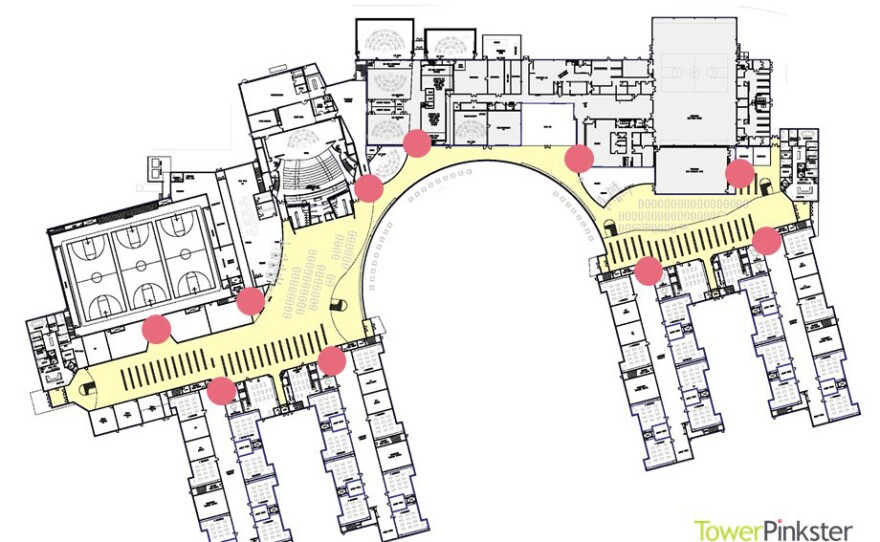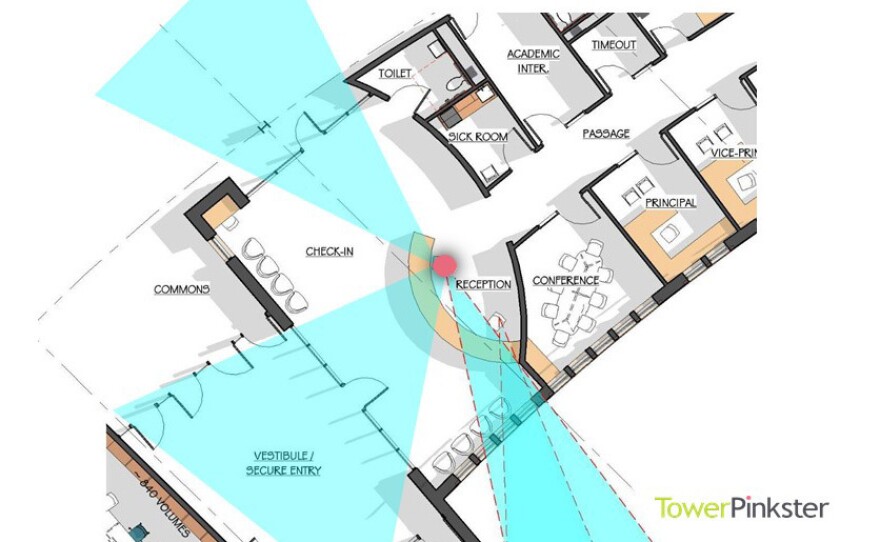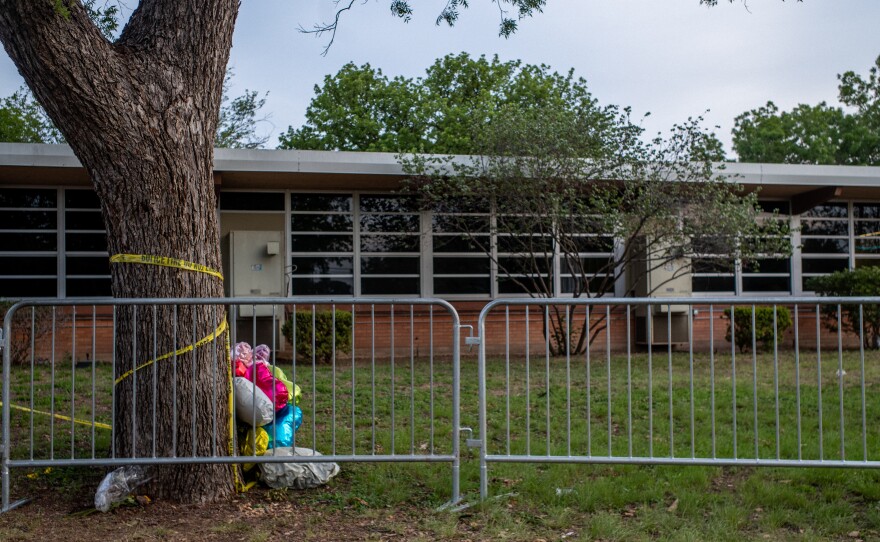A metal detector beeped, and Pastor Julián Moreno was turned away from his grandson's school field day in February – until he put his orange pocket knife back in his truck.
At first, he found it aggravating.
"But then as I was walking back, I remembered what happened at Robb and it kind of sunk in," said Moreno, who lost his great granddaughter, Lexi Rubio, in the shooting in Uvalde, Texas last May. "They were just trying to do a better job."
Many schools in America, like the one Moreno's grandson attends, have installed metal detectors and fortified their entrances in response to the threat of school shootings.
But others, like Fruitport High School in Michigan, have opted to completely redesign their buildings' architecture – spending $48 million to incorporate curved hallways and little nooks for students to hide in, among other safety-driven upgrades.
"Architectural designs will be very important. And hopefully they will focus on really getting better security for schools and students and children," Moreno said, hoping districts "really know and take into consideration the pain in people's lives right now."
Decades in the making: how schools have changed since the 1970s
Over the past five decades, schools have taken various approaches to improve safety, said Gregory Saville, who edited the International Crime Prevention Through Environmental Design Association, or CPTED's, guidebook on school design.
"Schools simply were these boxes, the red stone buildings of, you know, 'Ozzie and Harriet' back in the forties and sixties," Saville said. "They simply had teachers [and principals] watching... But that was it."
Around the same time CPTED was created, that started to change, and schools began installing cameras and trimming hedges to improve sight lines. Saville said that was part of a larger architecture and urban planning movement, looking at ways to reduce crime in physical environments.
But now, instead of calling for fortified entrances and security features that can put students on edge, experts are calling for a more holistic approach – where architecture serves as a conduit for both physical security and for supporting students' mental health to prevent violence in the first place.
"They have these hallways and lockers, but there's no place to hang out, no place to socialize," said architect Rene Berndt, who is part of CPTED's board of directors. "And so, we're trying our best to create these moments, to use these areas to create some kind of social cohesion, to actually avoid the whole concept of some students being pushed so far out and so alienated, you know, that [they don't] really have a place to belong."

Designing schools in response to school shooting threats
There are no set guidelines firms have to follow when it comes to redesigning schools for safety, but Michigan-based TowerPinkster has taken some lessons from CPTED. And, as of August 2022, the firm said it has worked with between 50 and 60 districts in the western part of the state – completing about $500 million worth of K-12 design each year.
"When a community makes a significant investment, that's one of the top things they're asking for is, you know, 'we want our $50 million new project, whether it's a new school or an additional renovation or something, be safe to be the safest it can be today.' So that's usually a top concern," said Matt Slagle, the director of K-12 education at TowerPinkster.
Ultimately, the firm will follow what schools want, Slagle said. But certain features – including common areas for students' lockers, winged walls to disrupt sightlines and small spaces for students to be alone – are becoming more popular.
"The question we asked [students] was...if you need a moment of alone time, where do you go?" Slagle said, who noted that the COVID-19 pandemic caused a lot of students to struggle emotionally. "Fifteen percent of them said the bathroom."
Just as the firm has tried to create small "kid-shaped" spaces for students to be alone, architects are also working to design more community spaces for students to interact with one another.
"We need spaces that tear down those walls, that build bridges, that solidify our connection and relationships to one another, so that we know one another so well that if someone is having an off day, they can recognize it before it ever escalates into something more serious," said Judith Hoskens, who serves on the American Institute of Architects' leadership group.
She noted that several schools have recently built learning communities, where the campus is broken into several "neighborhoods" of about 150 students – allowing students to forge a tight-knit community with common areas.
But they also give teachers options of what to do in case the school locks down.
"The teacher has the flexibility to be able to determine which room is going to be most safe for that particular situation, whether it's shelter in place, or whether the students need to get out of the building as fast as possible," Hoskens said. "And so there would be the ability for the students to leave the learning neighborhood without having to go back and exit through the front entry of the school."

Since the shooting at Columbine High School in 1999, a lot of schools, Slagle said, are also opting to create a single, secure entrance, or vestibule, where school staff can monitor who comes in and goes out. This principle, he said, comes from the Panopticon – a design feature originally used in prisons where one person can see out in all directions.
Jill Renihan is the Director of Safe Schools at the Hernando School District in Brooksville, Florida. She's been on the job since 2018 – the same year as the Marjory Stoneman Douglas High School massacre in Parkland.
When she arrived, Renihan was given a budget of about $800,000 from the state to firm up the schools' security. With that money – and additional help from the district – the Hernando School District revamped its perimeters and added vestibules to its schools' entry ways.
"The other piece that we needed to do for [the] perimeter was really to start to harden those kinds of openings into our campuses," she said. "So, I really tried to take a layered approach, making sure that we had a good, strong perimeter and then working my way into the inside of the campus."
The project, which also included upgraded intercoms and locks was "certainly a budget impactor" for the district, but it didn't prevent the district from diverting money away from other priorities, Renihan added.
"We're public institutions that are there to provide this service of educating students, so we can't ever lose sight of that," she said, noting that the district has tried to "blend in" its security features and not make students feel "locked away or that they're locked in."
Subjectivity in safety
Hoskens, who sits on the American Institute of Architects leadership group, has worked with a number of schools in Maryland that have taken more hardened approaches, fortifying their campuses and adding metal detectors at entrances. And while many schools throughout the country have relied on similar measures, these strategies can do more harm than good, she said.
"In some communities, that had the opposite effect of what's desired," Hoskens said. "It actually raises more fear in the students than the calming effect."
Sandy Hook Elementary in Connecticut, she noted, continued to "be a place for learning and a place for children" even though it experienced a major school shooting. And advocates with March For Our Lives, a student-led movement created after the shooting at Stoneman Douglas High School, have insisted schools should be "playful, joyful places—not cold, dark, hardened places."
Meanwhile, some relatives of victims, like Moreno, just want to see something – anything – done.
Feeling safe is subjective, Hoskens added, and what works for one school or community won't necessarily work for another.
Even within school districts, various stakeholders have different ideas. Before he starts designing schools, Berndt surveys the teachers, students and parents within the community, and each of these groups have their own views.
At a school district in Eugene, Oregon, teachers told Berndt they want secure perimeters and straightforward pathways that make it easy to walk through hallways, while students have expressed a longing to interact with their peers and feel seen.
Putting up their artwork and letting "students make their school their canvas," is one way to foster that sense of community, Berndt said. Bringing plant life indoors and using softer materials like wood for the interior can also help.
For many parents, peace of mind meant having a safe vestibule to enter through and someone at the front entrance to greet visitors.
"It's all subjective," Berndt said. "Safety is a very emotional feeling as well.... It's sort of a mental trust."
Barriers to widespread school redesign
Despite widespread support for updating campus designs, Saville, the editor of CPTED's guidebook, said redesigning them in the interest of student safety isn't as common as he'd like to see, and hardening schools continues to be more popular.
But best practices can take "a decade or two to permeate through the public narrative," he said.
Meanwhile, Saville noted some schools may be apprehensive because acknowledging threats of shootings in more overt ways – like rebuilding parts of a campus – can instill fear in parents.
"You don't want to terrify parents," Saville said. "I mean, schools are already poorly funded as it is. And they certainly don't want to [push] parents away, and [push] them into charter schools or [push] them into homeschooling."
And for other schools – it could just boil down to dollars and cents.
"The desire is there. It's a matter of funding," said Berndt, who added that "it's a matter of inviting the community to contribute" and get bond measures passed.
TowerPinkster mainly works with public schools, but Slagle, the firm's director of K-12 education, said a schools' ability to redesign also has to do with "a disparity across the United States on how schools are funded."
"If you're somebody from a smaller community, you might only be able to do certain things, where a more affluent community... might have more opportunity to make change quicker," he added.
A sense of urgency
Though several experts say architecture can be critical in preventing school shootings, March For Our Lives advocates believe tighter gun laws are the only solution in the long run.
The Biden administration announced an executive order Tuesday that would make it harder for firearm sellers to avoid doing background checks. Now, it's up to Congress to decide.
"It's far more efficient and effective to address the root causes of gun violence by enacting and enforcing laws that ensure that anyone who might do harm to our kids can never get access to a gun," said March For Our Lives spokesperson Noah Lumbantobing.
About a third of parents nationwide are "very or extremely worried" about an active shooter threat at their child's school, according to a study released by Pew Research in October, 2022. And the majority of parents across party lines say screening for and treating mental illness could play a critical role in reducing school shootings moving forward.
Meanwhile, survey data from March For Our Lives found that 52% of people under the age of 35 are worried about their personal safety from a mass shooting.
"We can get into discussions about gun control and changing the Second Amendment, you know, forever. And as much as we morally believe that's right...the genie is out of [the bottle]," Saville, the editor of CPTED's guidelines, said. "There's millions of guns out there, and access in some states is simply a matter of walking into a store. And so, we have to do something in the short term. We can't wait."
Copyright 2023 NPR. To see more, visit https://www.npr.org. 9(MDAzMjM2NDYzMDEyMzc1Njk5NjAxNzY3OQ001))







